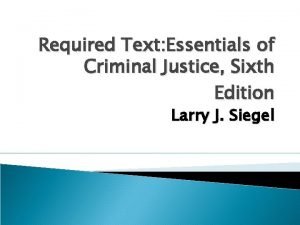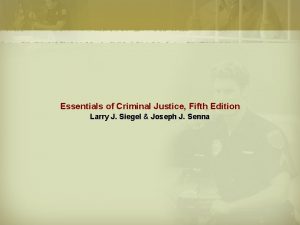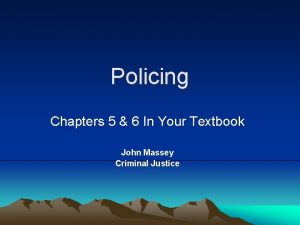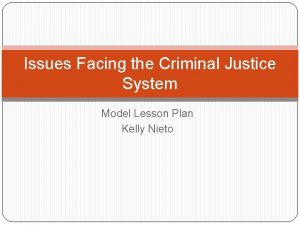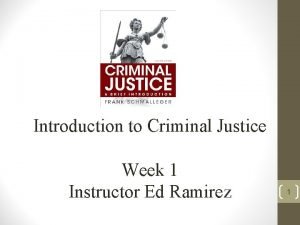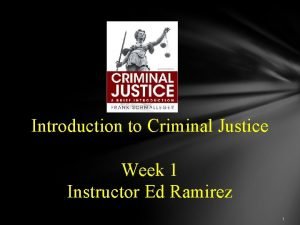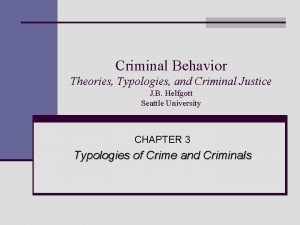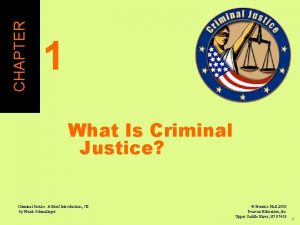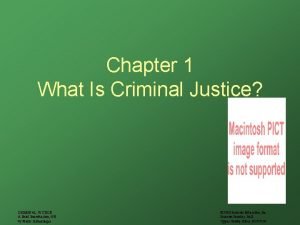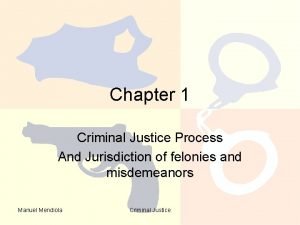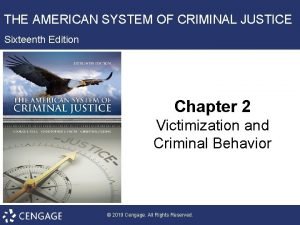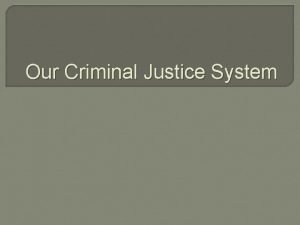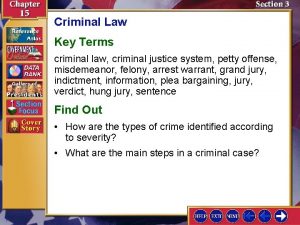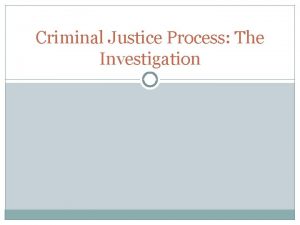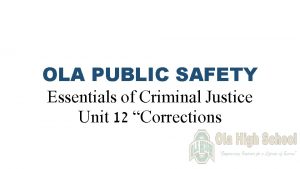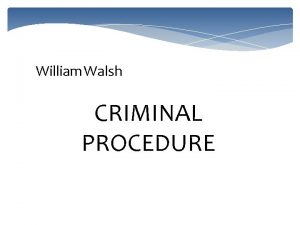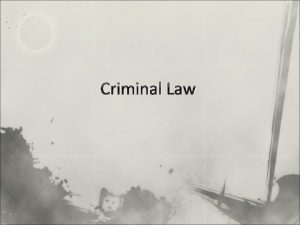Use of Force Criminal Justice Essentials Unit 7




























- Slides: 28

Use of Force Criminal Justice Essentials Unit 7 SS s 7. 1 & 7. 2 Essential Question: How are police allowed to protect themselves?

Federal Law Enforcement Training Center (FLTEC) Use of Force Essential Question: How are police allowed to protect themselves?

Use of Force Issues The purpose of any force use is to gain compliance Pain cannot be used to punish Police are allowed to use a higher level of force than the suspect We don’t have to fight fair Essential Question: How are police allowed to protect themselves?

Use of Force Issues Must go by what officer knew at the time Gun found to be unloaded not an issue Weapon can be anything: car, chair, or anything else that may cause death or serious injury Reasonableness” is the standard Least force not required Essential Question: How are police allowed to protect themselves?

Reasonableness Factors: Degree/extent of force Location/place Part of official duty Totality of circumstance Essential Question: How are police allowed to protect themselves? Severity of crime Was suspect immediate threat to officer/others Suspect resistance Evasion/fleeing

Important Deadly Force Case Tennessee v. Garner (1985) Cannot shoot a fleeing felon Can only shoot if they are a danger to the public Shooting is considered a seizure Deadly force may be used if the suspect “Uses or threatens to use…” Jeopardy – Critical element to justified use of force Essential Question: How are police allowed to protect themselves?

Deadly Force Issues No warning shot Bullets will travel 500 feet to 2 miles depending on weapon Bullets will go through walls, doors, and even some metals Essential Question: How are police allowed to protect themselves?

Use of Force Continuum Essential Question: How are police allowed to protect themselves?

Deadly Force Active Aggression-punches Defensive Resistance - push Passive Resistance - limp Verbal non-compliance - No! Psychological Intimidation - stare Essential Question: How are police allowed to protect themselves?

Reassess! You must REASSESS the use of force after each use (i. e. strike, shot, etc. ) Excessive Force – Not using appropriate level in response to threat &/or failure to reassess Police Brutality - Intentional inappropriate use of force Is this brutality? Media Clip Essential Question: How are police allowed to protect themselves?

Compliance Weapons Once called Non-Lethal or Less than Lethal Essential Question: How are police allowed to protect themselves?

Taser Electro-Muscular Disruption 35 foot max range Tasercam records Works on animals Media Clip Funny Clip Essential Question: How are police allowed to protect themselves?

Oleoresin Capsicum Spray Capsaicin – found in range of plants including peppers Burning sensation in nasal/eye area Dye is added Deactivation required Media Clip Essential Question: How are police allowed to protect themselves?

Batons Oldest of police weapons PR-24 is a modified martial arts weapon Expandable batons more compact Essential Question: How are police allowed to protect themselves?

Batons Hollow metals used for better impact Baton strike chart example here on right Essential Question: How are police allowed to protect themselves?

K-9 Duty/tactical K-9 is trained to search and subdue In 1970’s K-9 s not popular due to civil rights era images Most dogs from European trainers Essential Question: How are police allowed to protect themselves?

Diversionary Devices Used by SWAT Sound wave and flash cause disorientation Limited fire risk Essential Question: How are police allowed to protect themselves?

Other “Less than Lethal” Pepperball Guns Rubber Bullets Sticky Foam Bean Bag Round Emerging technology such as microwaves, directed energy, etc Essential Question: How are police allowed to protect themselves?

Deadly Force Once called Non-Lethal or Less than Lethal Essential Question: How are police allowed to protect themselves?

Handguns Convenient size, but not the best weapon 2 types Revolver Semi-Auto Essential Question: How are police allowed to protect themselves?

Handguns Guns are identified by barrel measurement . 22 . 38 . 45 9 mm (metric) Caliber Media Clip Essential Question: How are police allowed to protect themselves?

Handguns Semi-Autos have key parts Slide Spring Barrel Trigger Guard Media Clip Firing pin Magazine Essential Question: How are police allowed to protect themselves?

Handguns Bullet types Wad cutter Hallow point Slug Talon Glazer Safety slug Essential Question: How are police allowed to protect themselves?

Handguns Bullets are made of 4 parts: Bullet Case Propellant Primer Essential Question: How are police allowed to protect themselves?

Rifles Far more accurate and more damage Also identified by barrel width Rifling makes bullet more accurate Like a football Essential Question: How are police allowed to protect themselves?

Shotguns Very powerful Limited distance Bullets are slugs, pellets, or combination Can shoot gas, bags, etc Barrel is by gauge Essential Question: How are police allowed to protect themselves?

Use of Force Examples Essential Question: How are police allowed to protect themselves?

Use of Force Introduction to Law & Justice Unit 6 Essential Question: How are police allowed to protect themselves?
 Essentials of criminal justice
Essentials of criminal justice Criminal justice wedding cake diagram
Criminal justice wedding cake diagram Criminal law and juvenile justice unit 2
Criminal law and juvenile justice unit 2 Guelph university criminal justice and public policy
Guelph university criminal justice and public policy What are the branches of criminal justice system
What are the branches of criminal justice system Division of criminal justice ct
Division of criminal justice ct Grass eater police
Grass eater police Criminal justice lesson
Criminal justice lesson Consensus model criminal justice
Consensus model criminal justice Consensus model criminal justice
Consensus model criminal justice Define corrections in criminal justice
Define corrections in criminal justice Four pillars of criminal justice system
Four pillars of criminal justice system Consensus model criminal justice
Consensus model criminal justice Criminal typology
Criminal typology Individual rights
Individual rights Consensus model criminal justice
Consensus model criminal justice Consensus model criminal justice
Consensus model criminal justice Nonintervention perspective of criminal justice
Nonintervention perspective of criminal justice Criminal justice wedding cake
Criminal justice wedding cake Arizona criminal justice information system
Arizona criminal justice information system Responsibilities of saps in the criminal justice system
Responsibilities of saps in the criminal justice system New york state division of criminal justice services
New york state division of criminal justice services National archive of criminal justice data
National archive of criminal justice data Criminal justice
Criminal justice Types of intermediate sanctions criminal justice
Types of intermediate sanctions criminal justice Conflict theory criminal justice
Conflict theory criminal justice Data analysis in criminal justice
Data analysis in criminal justice The american system of criminal justice 16th edition
The american system of criminal justice 16th edition Notas rojas
Notas rojas
